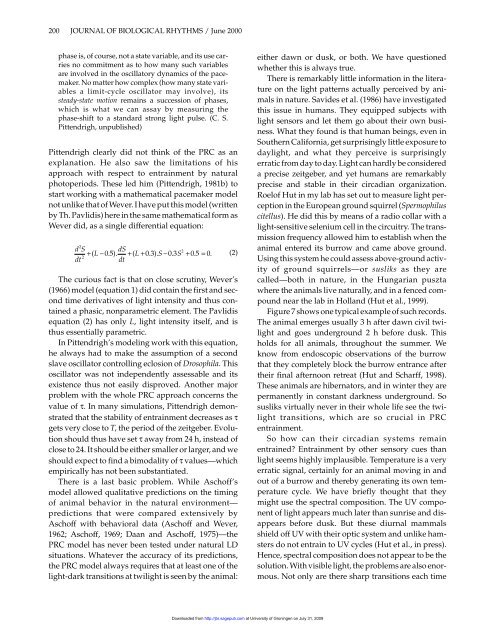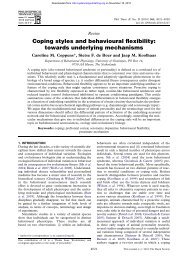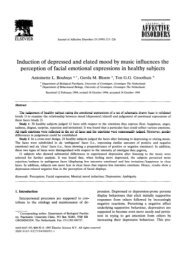Colin Pittendrigh, Jürgen Aschoff, and the Natural Entrainment - CBN
Colin Pittendrigh, Jürgen Aschoff, and the Natural Entrainment - CBN
Colin Pittendrigh, Jürgen Aschoff, and the Natural Entrainment - CBN
You also want an ePaper? Increase the reach of your titles
YUMPU automatically turns print PDFs into web optimized ePapers that Google loves.
200 JOURNAL OF BIOLOGICAL RHYTHMS / June 2000<br />
phase is, of course, not a state variable, <strong>and</strong> its use carries<br />
no commitment as to how many such variables<br />
are involved in <strong>the</strong> oscillatory dynamics of <strong>the</strong> pacemaker.<br />
No matter how complex (how many state variables<br />
a limit-cycle oscillator may involve), its<br />
steady-state motion remains a succession of phases,<br />
which is what we can assay by measuring <strong>the</strong><br />
phase-shift to a st<strong>and</strong>ard strong light pulse. (C. S.<br />
<strong>Pittendrigh</strong>, unpublished)<br />
<strong>Pittendrigh</strong> clearly did not think of <strong>the</strong> PRC as an<br />
explanation. He also saw <strong>the</strong> limitations of his<br />
approach with respect to entrainment by natural<br />
photoperiods. These led him (<strong>Pittendrigh</strong>, 1981b) to<br />
start working with a ma<strong>the</strong>matical pacemaker model<br />
not unlike that of Wever. I have put this model (written<br />
by Th. Pavlidis) here in <strong>the</strong> same ma<strong>the</strong>matical form as<br />
Wever did, as a single differential equation:<br />
2<br />
d S dS<br />
2<br />
+ ( L − 0. 5). + ( L + 0. 3). S − 0. 3S + 0. 5 = 0.<br />
(2)<br />
2<br />
dt<br />
dt<br />
The curious fact is that on close scrutiny, Wever’s<br />
(1966) model (equation 1) did contain <strong>the</strong> first <strong>and</strong> second<br />
time derivatives of light intensity <strong>and</strong> thus contained<br />
a phasic, nonparametric element. The Pavlidis<br />
equation (2) has only L, light intensity itself, <strong>and</strong> is<br />
thus essentially parametric.<br />
In <strong>Pittendrigh</strong>’s modeling work with this equation,<br />
he always had to make <strong>the</strong> assumption of a second<br />
slave oscillator controlling eclosion of Drosophila. This<br />
oscillator was not independently assessable <strong>and</strong> its<br />
existence thus not easily disproved. Ano<strong>the</strong>r major<br />
problem with <strong>the</strong> whole PRC approach concerns <strong>the</strong><br />
value of τ. In many simulations, <strong>Pittendrigh</strong> demonstrated<br />
that <strong>the</strong> stability of entrainment decreases as τ<br />
gets very close to T, <strong>the</strong> period of <strong>the</strong> zeitgeber. Evolution<br />
should thus have set τ away from 24 h, instead of<br />
close to 24. It should be ei<strong>the</strong>r smaller or larger, <strong>and</strong> we<br />
should expect to find a bimodality of τ values—which<br />
empirically has not been substantiated.<br />
There is a last basic problem. While <strong>Aschoff</strong>’s<br />
model allowed qualitative predictions on <strong>the</strong> timing<br />
of animal behavior in <strong>the</strong> natural environment—<br />
predictions that were compared extensively by<br />
<strong>Aschoff</strong> with behavioral data (<strong>Aschoff</strong> <strong>and</strong> Wever,<br />
1962; <strong>Aschoff</strong>, 1969; Daan <strong>and</strong> <strong>Aschoff</strong>, 1975)—<strong>the</strong><br />
PRC model has never been tested under natural LD<br />
situations. Whatever <strong>the</strong> accuracy of its predictions,<br />
<strong>the</strong> PRC model always requires that at least one of <strong>the</strong><br />
light-dark transitions at twilight is seen by <strong>the</strong> animal:<br />
Downloaded from<br />
http://jbr.sagepub.com at University of Groningen on July 31, 2009<br />
ei<strong>the</strong>r dawn or dusk, or both. We have questioned<br />
whe<strong>the</strong>r this is always true.<br />
There is remarkably little information in <strong>the</strong> literature<br />
on <strong>the</strong> light patterns actually perceived by animals<br />
in nature. Savides et al. (1986) have investigated<br />
this issue in humans. They equipped subjects with<br />
light sensors <strong>and</strong> let <strong>the</strong>m go about <strong>the</strong>ir own business.<br />
What <strong>the</strong>y found is that human beings, even in<br />
Sou<strong>the</strong>rn California, get surprisingly little exposure to<br />
daylight, <strong>and</strong> what <strong>the</strong>y perceive is surprisingly<br />
erratic from day to day. Light can hardly be considered<br />
a precise zeitgeber, <strong>and</strong> yet humans are remarkably<br />
precise <strong>and</strong> stable in <strong>the</strong>ir circadian organization.<br />
Roelof Hut in my lab has set out to measure light perception<br />
in <strong>the</strong> European ground squirrel (Spermophilus<br />
citellus). He did this by means of a radio collar with a<br />
light-sensitive selenium cell in <strong>the</strong> circuitry. The transmission<br />
frequency allowed him to establish when <strong>the</strong><br />
animal entered its burrow <strong>and</strong> came above ground.<br />
Using this system he could assess above-ground activity<br />
of ground squirrels—or susliks as <strong>the</strong>y are<br />
called—both in nature, in <strong>the</strong> Hungarian puszta<br />
where <strong>the</strong> animals live naturally, <strong>and</strong> in a fenced compound<br />
near <strong>the</strong> lab in Holl<strong>and</strong> (Hut et al., 1999).<br />
Figure 7 shows one typical example of such records.<br />
The animal emerges usually 3 h after dawn civil twilight<br />
<strong>and</strong> goes underground 2 h before dusk. This<br />
holds for all animals, throughout <strong>the</strong> summer. We<br />
know from endoscopic observations of <strong>the</strong> burrow<br />
that <strong>the</strong>y completely block <strong>the</strong> burrow entrance after<br />
<strong>the</strong>ir final afternoon retreat (Hut <strong>and</strong> Scharff, 1998).<br />
These animals are hibernators, <strong>and</strong> in winter <strong>the</strong>y are<br />
permanently in constant darkness underground. So<br />
susliks virtually never in <strong>the</strong>ir whole life see <strong>the</strong> twilight<br />
transitions, which are so crucial in PRC<br />
entrainment.<br />
So how can <strong>the</strong>ir circadian systems remain<br />
entrained? <strong>Entrainment</strong> by o<strong>the</strong>r sensory cues than<br />
light seems highly implausible. Temperature is a very<br />
erratic signal, certainly for an animal moving in <strong>and</strong><br />
out of a burrow <strong>and</strong> <strong>the</strong>reby generating its own temperature<br />
cycle. We have briefly thought that <strong>the</strong>y<br />
might use <strong>the</strong> spectral composition. The UV component<br />
of light appears much later than sunrise <strong>and</strong> disappears<br />
before dusk. But <strong>the</strong>se diurnal mammals<br />
shield off UV with <strong>the</strong>ir optic system <strong>and</strong> unlike hamsters<br />
do not entrain to UV cycles (Hut et al., in press).<br />
Hence, spectral composition does not appear to be <strong>the</strong><br />
solution. With visible light, <strong>the</strong> problems are also enormous.<br />
Not only are <strong>the</strong>re sharp transitions each time





